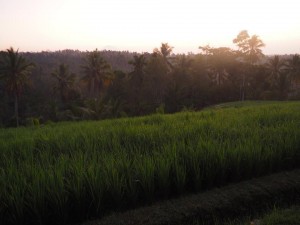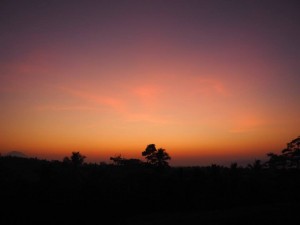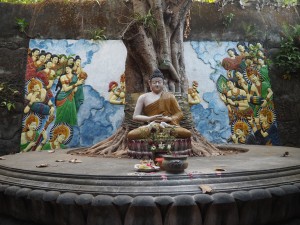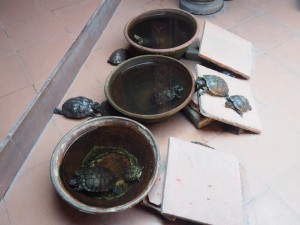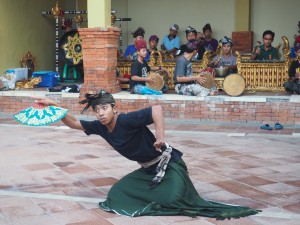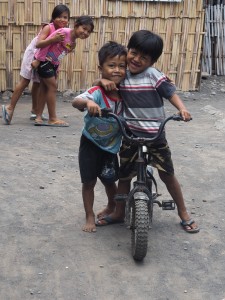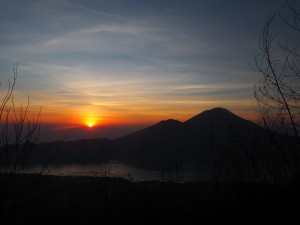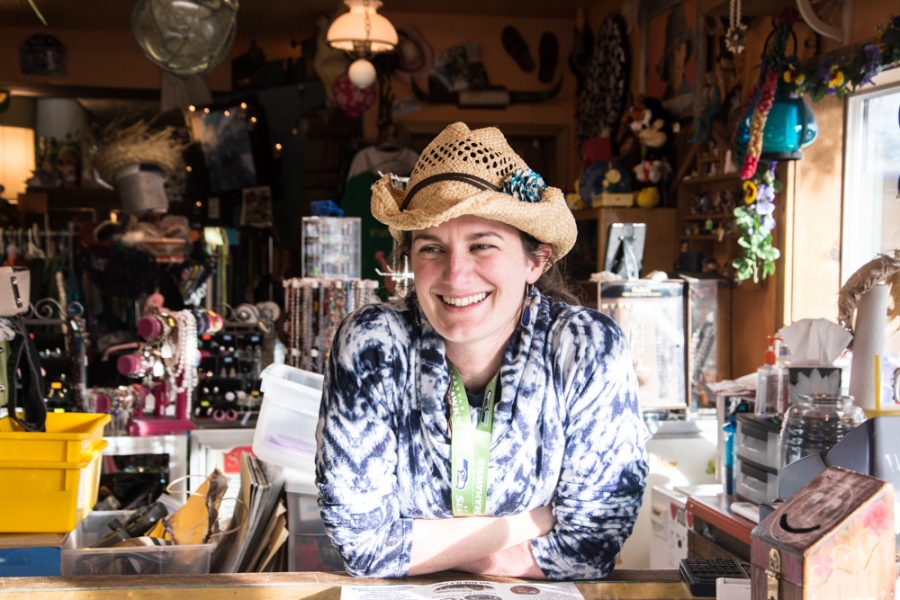As promised, here is a recap of the second half of my weeklong excursion, this part featuring adventures in North Bali. As you first read this entry the title may seem misleading, although I can assure you that I did in fact climb a volcano…I just did some other things first. But keep reading on if you want to hear about volcano adventures.
On our last morning in the village, I woke up at five with many people from my group and walked to the closest highest point near the village to watch the sunrise. I wish it was possible to capture the beauty of the early sun on the rice fields, but sadly even a picture doesn’t do it justice. In the approximately 45 minutes that we sat on the top of the hill, surrounded by green rice fields and palm trees, the sky went from starry and dark to colorful, accented by mountains on the horizon. As you may have seen in my last post, the landscape of rice fields – green steps cut into the earth – seems to exemplify the beauty of Bali, and are becoming more and more rare as hotels and restaurants are built. So, waking up before the sun, experiencing the rare feeling of cold in Bali, and then watching the rice fields become illuminated by the colorful sky was the most appropriate way to say goodbye to the real Bali, the natural and traditional rice cultivating culture.
Soon we were on our way, slightly tired from rising early but excited to venture up north. On the way we stopped at a temple so our Academic Director could give a few offerings, as it was an auspicious day. This likely seems so foreign to those reading from outside of Bali, but here it’s like second nature. As you’ve probably gathered from my past posts, there are so many ceremonies in Bali. In fact, I now read that in the voice of a Balinese person, as many have said those exact words to me.
When we reached North Bali, Lovina to be specific, we took in the sight of the ocean, as well as the massive dolphin statue. Apparently Lovina is the place to spot them, although sadly we didn’t see any while we were there. A little while after we arrived, we visited a Buddhist monastery in the area, which I really enjoyed because I was in other countries this past summer that were prominently Buddhist, so it was interesting to see Buddhism in practice here. There were a number of different buildings in the complex, all with Buddha statues and murals. There was even a mini Borobudur (see my Java post if you’re not sure what this is!), and a banyan tree with a statue of Buddha teaching at its base. I’m not really sure if I could last through a meditation retreat, but this monastery seems like the kind I would want to be at if I could. While we were there we even glanced at the schedule for a retreat, and it basically was alternating sitting meditation and walking meditation, after rising super early in the morning.
We had one full day in Lovina, and it was jam packed. To start, we stopped at a Chinese temple, which was my first big exposure to Confucianism in Bali. As I think I said in an earlier post, Indonesians must choose one of six religions, and their affinity is printed on their ID card. Confucianism is the most recent one of the six to be recognized, and is a small minority group, especially on Bali. In the temple we all prayed, which consisted of putting many red incense sticks in pots located around the temple. I enjoyed praying, but I think my favorite part of the temple were the turtles located in the center, signifying long life. I don’t think I’ve seen that many turtles since I visited the zoo years ago.
From the Chinese temple we drove on to Gitgit waterfall, which I loved because it reminded me of the waterfalls back home in the Pacific Northwest. Most of our group stripped down to bathing suits and jumped into the water, but I’m a wimp and thought it was too cold. After hiking back up to our cars (past many souvenir stalls, a common sight in places like this that attract lots of tourists), we had lunch and I was able to get one of my favorite Bali drinks, es jeruk (iced fresh orange juice).With bellies full of gado gado (vegetables and peanut sauce), ayam kechap (chicken in a sweet sauce), nasi (rice), tempe, cap cay (sauteed vegetables), and mie goreng (fried noodles), we went on to our last stop, which was my favorite of the whole day.
The place was called Santhi Budaya, and is basically a traditional and contemporary dance and gamelan school. Kids attend classes there as an extracurricular, starting fairly young until as old as mid-twenties. The kids were amazing. They performed a few dances with us and invited us to do their warm ups with them, which I somewhat failed at since I basically just watched them the whole time. The dancing was considered contemporary by Balinese standards, but it still used many traditional aspects of dance like precise hand movements and the dancing stance (basically feet flexed, toes up, knees bent, but out, chest forward…not so easy!). We also saw a solo dance done by a young man which was really interesting to watch because most of the dancing (besides mask dancing) that I have seen has been performed by women. I took a few videos of the dancing, one of which I will post a link to below, so check it out! This group is so talented and even performs around the world!
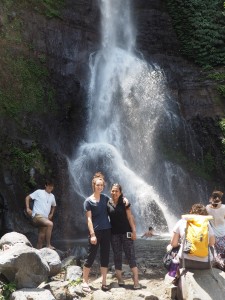
Click here to see the video. Just a warning, the music is loud so don’t have your volume up too loud. Also, it’s probably better watched in HD if you have a fast enough connection.
On our way out of Lovina the next morning, we stopped at a large village (in my opinion, more a small town) called Sangsit that is known for having religious harmony, as it is made up of both Hindus and Muslims (and some Confucianists). I believe many years ago Muslims came to Sangsit as either traders or fishermen, and since then Hindu community openly welcomed them. Since then supposedly they all work together, respect each other’s religious differences, and even provide support during major religious holidays. We were only in the village for a short time and only saw one family’s compound, which looked a bit more like houses we saw in Java – not quite as ornately decorated, and obviously no family temples as it was a Muslim house. I wish we had the chance to stay in the village longer, as I’m curious to see if this so-called religious harmony is actually true, but I think I’d probably have to talk to a lot of people or live there a long time to get to the bottom of it all.
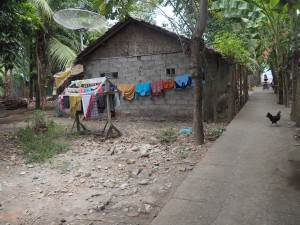
After our stop in Sangsit Village and a two hour long twisty turny drive, we made it to Kintamani, which is more central-eastern Bali, and where Mt. Batur is located! Batur is a volcano that is about 6,000 ft above sea level, and has two calderas. The outer caldera is massive, and contains a lake that people live around. The inner caldera is what people commonly climb, and also what has more recently erupted. The volcano is still active, althoughI don’t think recent eruptions have caused major damage in the area. We arrived mid-afternoon, and spent the rest of the day relaxing in preparation for our climb the next day. That night I set my alarm for one for the earliest times ever to have graced my alarm clock – 3:00 am – as we had to be ready to climb at 3:30 am. Of course, in true Bali (and SIT Bali group) fashion, we didn’t depart until after 4:00 am, but it was still completely dark and freezing. For the first hour or so we walked through what seemed like forested land, until we finally hit gravel and began to ascend. Unlike most climbs or steep hikes I’ve done in the past, the trail was hardly marked and there were no switch backs. Plus, because we were climbing a volcano, there was volcanic gravel everywhere, which is quite difficult to walk on.
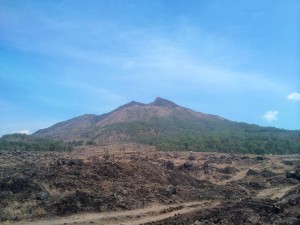
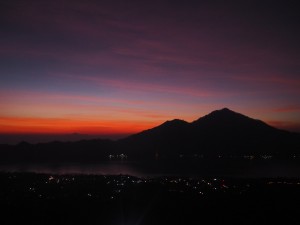
The sun began to rise when I was about halfway up the volcano, which gave me a good excuse to stop every once in awhile to catch my breath. It was incredible, lighting up the whole sky with reds and oranges and even illuminating a volcano that is on the island of Lombok. Sadly I did not make it to the top before the sun totally rose, but I didn’t mind because there was something special about climbing, stopping, looking at the sky, and feeling empowered to keep climbing. I feel like this all seems incredibly cliche, but I don’t know how else to describe how I felt on the side of the volcano. I had thought of myself as totally out of shape (exercise is not really a thing here in Bali), but I felt physically and mentally recharged and strong as I climbed on the volcanic rocks.
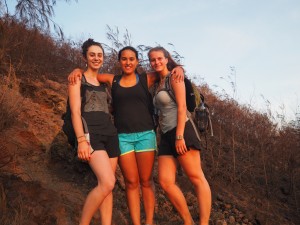
When we finally made it to the top, we were greeted by cool winds and the rest of our shivering group. I am ashamed to admit that in the one instance where I could have really used the sweatshirt I brought with me on the trip, it was sitting where it has been sitting since I flew here late August – in my suitcase at my homestay. But, the view from the top made it all worth it. Plus, as we had been climbing, our guides were working on making our breakfast…in the side of the volcano. Yep, they dug holes out of the top of the caldera, buried eggs, and then served them to us hard-boiled. My egg was a bit of a fail, though, as when I tried to crack it on the table it exploded everywhere. Apparently volcano cooking isn’t always the best method. I still was able to enjoy a breakfast of warm bananas in between slices of white bread (surprisingly good for regaining energy), and a little fruit.
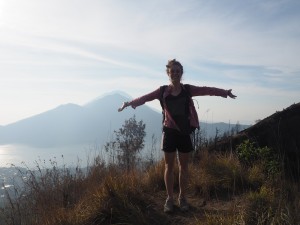

Our climb down was not so pleasant, as the loose gravel that was a nuisance going up became a slipping hazard on the way down. Many people in our group fell, although thankfully the worst injuries were just scrapes. When we finally ended the hike it was only mid-morning, and we were able to rest in the car until we reached home.
Overall, I think this weeklong excursion showed me multiple sides of Bali that I hadn’t seen before – the tourist-less village, the diversity of religion up north, and the beautiful nature that reminds me that I really am in Indonesia, the Volcanic Ring of Fire.

